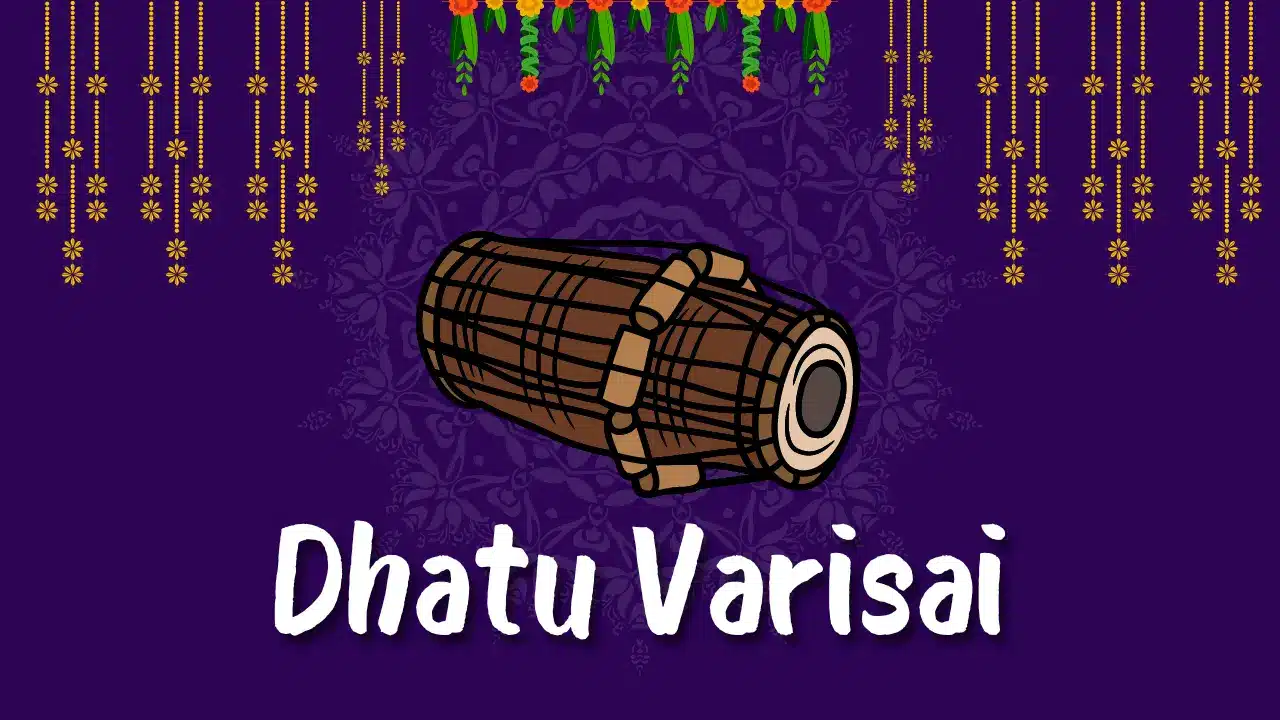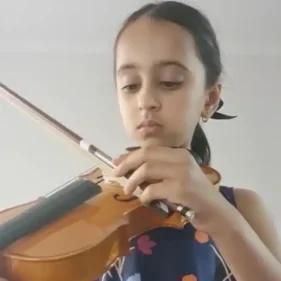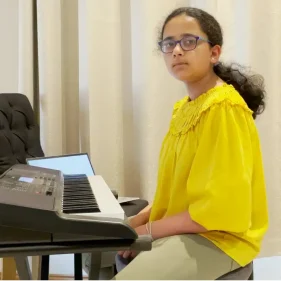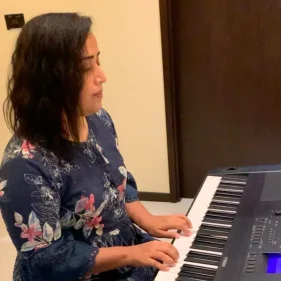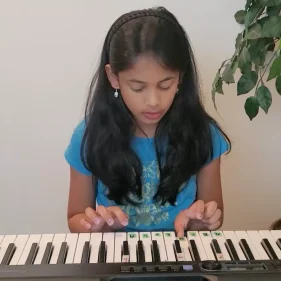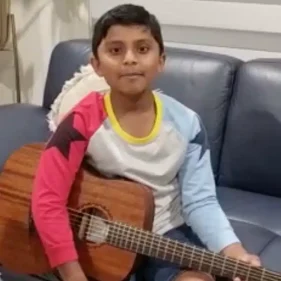Dhatu Varisai lessons are the basic and an essential exercise in Carnatic music. It focuses on developing the agility and control of a learner’s voice. In this blog post, we will discuss the importance and different aspects of Carnatic Music’s Dhatu Varisai. We will also explore some practice techniques that use this Tala and have a regime.
Before moving on you are expected to master the following two exercises:
1. Sarali Varisai
2. Janta Varisai
What is Dhatu Varisai?
Dhatu varisai exercises are an important part of beginner lessons in Carnatic music. The swaras are in non-linear patterns. It means that the Dhatu swaras are jumping between notes. These patterns help learners become more comfortable with singing swaras that are not in consecutive manner.
For example, a linear pattern would have swaras like, Sa Re Ga Ma Pa. Whereas a non-linear pattern would have swaras like Sa Ga Re Ma Pa. These patterns enhance vocal flexibility and precision.
Practiced in Mayamalavagowla raga, Dhatu varisaigal aids in pitchy stability and swara accuracy. You see, each exercise progresses in complexity which helps in handling faster note transitions while maintaining a good sense of clarity and rhythms.
Different Aspects
Dhatu varisai lesson introduces non-linear swara patterns to beginners. Swaras don’t move in step-by-step sequence. I’d always push my learners towards recognizing pitches and these Dhatu varisai notes train the ear to recognise and reproduce pitches.
This exercise is practiced in Adi Tala (8 beat cycle) which helps learners maintain rhythmic discipline while navigating complex swara jumps. Dhatu varisai, 4th lesson on Ganamrutha Bodhini, is also practised in different speeds(kala). This helps the learners build confidence and flexibility in both slow and fast passages.
How to Practice Dhatu Varisai in Carnatic Music?
To practice these exercises perfectly, one must first learn the various Dhatu Varisai practice techniques and right intonation it requires.
Kalpanaswaram patterns
One of the best ways to practice Dhatu Varisai swara patterns is by first learning the kalpanaswaram patterns. These patterns are very useful in helping you practice fluidly and smoothly, as they involve a lot of trills and techniques that require you to be agile and quick with your fingers.
You can also work on practicing these Varisai phrases yourself. This involves learning how to sing the various phrases commonly used in this style of music. Once you have learned the basic phrases, you can add a few details to it.
Breathing technique in check
Another critical aspect of practicing these Dhatu Varisai notes is to make sure that you use the correct breathing techniques. Incorrect breathing can often make you feel breathless and tired, making it challenging to sing smoothly.
Find the Right Shruti
Finally, it is also essential to ensure that you are using the right voice when practicing Carnatic Music Dhatu Varisai. This means using a voice that is neither too high nor too low, which has an excellent quality. If you use a voice that is too high or too low, it can often make the music sound forced and unnatural.
Practice in all 3 speeds for better results
You can then add tempo to the exercise and practice in 3 speeds as I have learnt. Once you have nailed the 1st speed, double the tempo with 2 swaras for 1 beat and 3 swaras for 1 beat and enjoy its fruitfulness.
Dhatu Varisai Progression Chart
| Level | Exercise Focus | Key Pattern Example | Learning Focus | Approximate Practice Time |
| Beginner | Basic Dhatu Varisa | Sa Ma, Re Pa, Ga Dha | Pitch Accuracy | 2-3 months |
| Early Intermediate | Complex jumps between swaras | Sa ga, Ma Pa, Re Dha Ni Sa | Vocal agility, Clarity of Raag | 3-4 months |
| Intermediate | Different speeds (kala) | Sa ga, Ma Pa, Re Dha Ni Sa | Control and Swara accuracy | 4-5 months |
| Advanced | Application of Raag | Mixed patterns in different Raag | Improvisation | 5-6 months |
[TABS_R id=12237]
Origin of Dhatu Varisai in South India
These lessons have its roots in the traditional gurukul system of South India. We may not be entirely sure of the single point of origin, Dhatu varisai fundamental patterns evolved organically as part of pedagogical methods for teaching carnatic music to the local folks. Its development is closely tied to Mayamalavagowla (common raga), which is known for its symmetrical scale making it ideal for beginners.

Did You Know?
Tanjore region in TamilNadu is known to be the historical hub for South Indian Classical music education.
Famous Compositions Having Carnatic Music Dhatu Varisai
By following these tips, you should be able to practice Dhatu Varisai of carnatic music relatively easily. Just remember to take your own time in focusing on each aspect of the music and also ensure that you are singing it correctly.
Some of the most famous compositions that use the Dhatu Varisai include works by renowned musicians such as Muthuswami Dikshitar, Syama Sastri and Tyagaraja.
One of the essential compositions that utilize this varisai is ‘Suryakantam’ by Muthuswami Dikshitar. This composition is an essential part of the ‘Melakarta’ ragas in Carnatic music.
Another popular composition that uses the Dhatu Varisai lessons is the famous Kriti ‘Neelakantam’ by Syama Sastri. It has become one of the essential works in Carnatic classical music.
Lastly, ‘Thillana Mohanambal’ by Tyagaraja is a well-known composition that uses the Carnatic Music Dhatu Varisai.
In addition to these works, many other compositions use this varisai, further adding its importance in the world of Carnatic music.
Dhatu varisai patterns are more challenging compared to Sarali varisai or Janta Varisai and mastery of this needs more practice from the student’s side. Dhatu Varisai lessons are practiced in Maya Malava Gowlava Raga & Adi Tala (8 beats).
Conclusion
Dhatu Varisai Notation is an important exercise in Carnatic music and should be learned and practiced with proper guidance. A professional Carnatic singing class can help you learn this Raga in the right way and give you access to some of the best teachers in the country.
If you are serious about learning Carnatic music, approach musicmaster institute today.
FAQs
What is Dhatu Varisai in Carnatic music?
Dhatu varisai is a 7 beat tala exercise zigzag sequence.
How to practice Dhatu Varisai for beginners?
Prior to the Dhatu varisai, it is crucial to practice Sarali Varisai lessons) progressively basic combinations of Dhatu varisai.
What are the swara notations for Dhatu Varisai exercises?
S R1 G3 M1 P D1 N3 S
S N3 D1 P M1 G3 R1 S
How does Dhatu Varisai contribute to music skill development?
This Varisai is an excellent way to improve coordination, timing, and musicality. It is also an excellent workout for the mind and body and can be very therapeutic.
Are there Dhatu Varisai lessons for advanced learners?
Dhatu Varisai lessons are basically same beginners and for advanced learners
What are common mistakes to avoid while practicing Dhatu Varisai?
Common mistakes include not knowing the shruti which makes learners difficult figure out swarsthaan.
How many Dhattu varisai are there?
There are 2 detailed exercises of Dhatu varisai.
What is the correct order to practice Dhatu varisai?
Each exercise needs to be practiced in First speed, Second speed and then third speed while maintaining Shruti and Talam.
Which guru's Dhatu varisai system is most popular?
Palaghat Mani Iyer, Karaikudi Mani and Trichy sankaran are the most popular Dhatu varisai systems.
Relate Blog: Difference Between Carnatic and Hindustani Music

